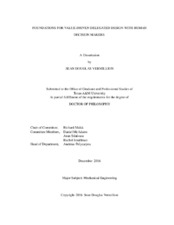| dc.description.abstract | Value-Driven Design is a paradigm that argues that the goal of the engineering design process is to create a system with maximum value. However, the design of large, complex systems undoubtedly requires the efforts of many individuals, and it is naive to think these individuals will act to maximize value if their own values are not maximized along the way. This research focuses on building the foundational knowledge for incentivizing the many individuals in large system design to make design decisions toward maximizing system value. Specifically, this dissertation uses the mathematical framework of normative decision making to formulate and evaluate incentives.
We formulate two promising incentive structures: the Piece Rate–where a marginal increase in system value yields a marginal increase in reward an individual will receive– and the Variable Ratio–where a marginal increase in system value yields a marginal increase in the probability of a reward to the individual. These incentive structures are evaluated twofold: (1) by how well they motivate an engineer to provide effort to search for an optimal design solution and (2) by how well they motivate an engineer to collaborate with other engineers to yield an optimal system design solution. We derive mathematical models of effort and collaboration provision for incentive evaluation.
Mathematical analysis suggests that which incentive structure motivates greater search effort or collaboration is contextual. The effectiveness of one incentive over the other for effort provision is dependent, in part, on the risk preferences of the engineer. The effectiveness of one incentive over the other for collaboration provision is dependent, in part, on how the incentive structures are scaled with respect to the feasible system alternative space. Therefore, the analysis in this dissertation suggests that the greater information a system-level manager has over the people in the design process and the general characteristics of the system design alternative space, the greater her ability for choose between the Piece Rate and Variable Ratio incentive structures to induce search effort and collaboration to maximize system value. | en |


